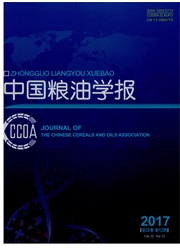

 中文摘要:
中文摘要:
采用近红外光谱技术构建红曲米中桔霉素、淀粉、水分含量的快速测定预测模型。分别采用偏最小二乘回归(PLS)、主成分回归(PCR)、多元线性回归(SMLR)构建所测组分的数学模型,以相关系数(R)、预测相对分析偏差(RPD)、预测均方根误差(RMSEP)、校正均方根误差(RMSEC)值来评价模型的综合性能。结果表明,MSC、SNV方法可以消除样品颗粒不均对光谱的散射影响;导数处理能够消除基线漂移问题;对于水分含量,只有PLS和PCR模型可用于较准确定量测定(RPD=2.45和2.81);对于淀粉,只有SMLR模型可用于较准确定量测定(RPD=2.58);对于桔霉素,3种模型的RPD值均小于2,虽然不能用于准确定量测定,但能满足定性分析或分级。为红曲米生产过程中桔霉素、淀粉、水分含量的快速检测提供新的方法,为红曲米质量的智能化控制提供新的途径。
 英文摘要:
英文摘要:
Prediction models about the rapid determination of citrinin, starch, and moisture content in red yeast rice was built using Near Infrared Spectroscopy (NIR). Principal component regression (PCR) , partial least squares (PLS) and Stepwise multiple linear regression (SMLR) were used to develop the prediction model, and correlation coefficient ( R), ratio of prediction to deviation ( RPD), root mean square error of predication (RMSEP) and root mean square error of calibration (RMSEC) were suggested to evaluate the performance of models. The results showed that MSC, SNV could eliminate spectral scattering causing by uneven red yeast rice parcels. Derivative treatment could eliminate the baseline drift. For moisture content, only PLS and PCR models were available for accurate quantitative determination ( RPD were 2.45 and 2.81 ). For starch, only SMLR model can be used accurate quantitative determination (RPD were 2.58). For citrin, RPD value of the three models were less than two, so it could not be used to accurate quantitative determination, but could be used to qualitative analysis or classification. The studies had shown that near - infrared spectroscopy technology has the potential beneficial for measure eitrinin, stach and moisture content in red yeast rice online and is conducive to intelligent quality control of red yeast rice.
 同期刊论文项目
同期刊论文项目
 同项目期刊论文
同项目期刊论文
 期刊信息
期刊信息
